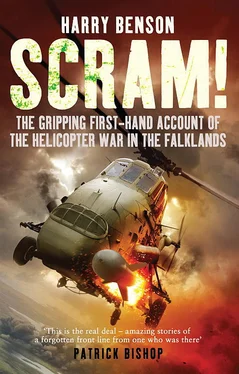A typical Wessex ‘flight’ comprised a couple of helicopters, aircrew and engineers, stuck on the back end of an auxiliary ship. Communication with the outside world was limited or difficult. Keeping up to date with events in South Georgia and the Falklands meant an almost total reliance on the BBC World Service news, transmitted over HF radio. Keeping in touch with the squadron hierarchy back at Yeovilton, let alone other flights dotted around the growing British fleet now heading south, was nigh on impossible apart from the odd few words on a signal. Flight commanders held a considerable degree of autonomy and responsibility as a result, relying on the ingenuity and experience of the entire flight to resolve unforeseen issues.
One such issue for Lomas and his team involved the flotation canisters that were normally plugged into the hub of each main wheel on the Wessex. These canisters contained a giant balloon that fired off, just like an airbag, in the event of a ditching at sea. The priority was not so much to save the aircraft but to keep the aircraft afloat long enough to improve the odds of escape for aircrew and passengers. The previous summer off the coast of the USA, a Wessex flown by Lieutenant Phil Doyne-Ditmas had suffered a tail rotor failure and ditched into the sea. Although only one ‘flot can’ fired, causing the aircraft to flip upside down under water, all of the crew and passengers managed to escape. The problem for Lomas was that it was impossible to fit the flot cans as well as the 2-inch rocket platform. Without a commanding officer or senior pilot to talk to, Lomas flew across to Fearless to talk to former boss Tim Stanning. ‘What the hell am I supposed to do, Tim? Our rocketry kit has been aligned. But it doesn’t seem a terribly sensible idea to be flying around the Bay of Biscay over water without flot cans.’
Stanning’s reply was straightforward. ‘You’re a gunship. Keep it that way.’ Sometimes it was good to have another experienced junglie around.
Even though the Royal Navy had been flying Wessex helicopters at sea for seventeen years, there were always situations that tested the initiative and creativity of the crew. Some procedures were made up on the hoof. One of the key threats the Wessex was thought likely to face, should the task force see action, came from fixed-wing aircraft. With his background as a Helicopter Warfare Instructor (HWI), Lomas and his team decided to turn the attack capabilities of the Wessex into defence. Instead of firing the rockets downwards onto a ground target, what would happen if they were pointed upwards at an incoming jet?
Lomas, Knight and their two other pilots, Sub-Lieutenants Richard ‘Noddy’ Morton and Steve ‘Wannafight’ Judd, had a fantastic time experimenting with flying past the ship at low level, raising the aircraft nose slightly, and firing off pairs of rockets. The rockets were designed to explode either on impact or after a period of time. Making notes after each firing, the crews soon worked out that they could get the rockets to explode fairly reliably a couple of miles away at about 500 feet. Although the likelihood of actually hitting an attacking jet was zero – it was bad enough trying to hit a stationary tank – it might make the pilot’s eyes water. And it was good for morale.
Chapter 4
Not a ‘first tourist’ day: 21 April 1982
THE SAS NEVER do things the easy way. Inserting a troop onto the top of the remote and inhospitable Fortuna Glacier in appalling weather was always going to push the survival skills of Britain’s finest to the limit. And that was assuming the 845 Squadron Wessex pilots could get them up there in the first place .
The most challenging element of an ambitious mission plan was to send the helicopters up there in close formation at night. As if the plan wasn’t tough enough already, a practice formation session confirmed that night-time was not the time to do it. The SAS plan launched in daylight marked the beginning of Operation Paraquat to take back South Georgia .
Two weeks after the initial Argentine occupation of South Georgia and the Falklands, the whole venture remained in the realm of a good April Fools’ joke. Many people still thought it would turn out to be just a bit of fun. Before long the politicians would get their act together and everyone could come home again. It was about to become very clear indeed that this was not to be the case.
Like Hector Heathcote, Mike Tidd was also in Northern Ireland when it all kicked off on Friday 2 April. He was surprised and disappointed not to get a phone call from Yeovilton asking him to get back fast. Eager not to miss out on the fun, he phoned in to Yeovilton. ‘Wait a few days and see how things pan out,’ said Booth.
A few days later, Tidd was taxiing his Wessex in to dispersal at Aldergrove after a long day flying in South Armagh. In front of him stood the grinning face of Lieutenant Ray Colborne (known to all as ‘Uncle Ray’), who was holding up a brown travel bag. After the rotors stopped turning, Colborne wandered over and handed Tidd the bag, telling him, ‘You’re off, my son! See that British Airways Tristar on the other side of the airfield? Best you get changed. You’re in the jump seat.’ The rest of Tidd’s team were already on their way, having been replaced by Colborne, two other experienced Wessex pilots, and three of the new baby junglies , including me.
Now dressed in civilian clothes and perched between the Tristar’s two British Airways pilots, Tidd looked down at the Irish Sea 30,000 feet below. Suddenly a cold sweat came over him. He realised he could feel his loaded 9mm pistol still hanging in its holster inside his bomber jacket. Heathrow security were unlikely to take kindly to a loaded weapon passing through their airport with no paperwork, especially coming from Belfast. On arrival he collected his flying kit bag and, thinking fast, grabbed a policeman. ‘Excuse me, old chap, I’m on my way to the Falklands and I’ve got a lot of kit. Any chance of some help?’ The unwitting policeman then led the armed Tidd all the way through customs and safely out the other side.
On the morning of Tuesday 6 April, Tiddles and his newly formed Wessex flight of Ian Georgeson, Sub-Lieutenant Andy ‘Boy’ Berryman, and RAF exchange pilot Flight Lieutenant Andy ‘Pullthrough’ Pulford, were the second team to arrive on Ascension. Two days later, they were assisting Nick Foster’s flight, lifting stores and troops out to Fort Austin . On 11 April, the flight embarked on RFA Tidespring , a large oiler, destined to head off with the warships Antrim and Plymouth for South Georgia. After collecting a few more stores from the returning Fort Austin en route, the group continued south to rendezvous with HMS Endurance .
It was at this stage that the SAS hatched their bold plan to launch from one of the ships by helicopter, land a team of sixteen men on Fortuna Glacier, march down the central spine through the mountains, and take the Argentine troops by surprise from the rear. As if this plan wasn’t sufficiently daring and risky, the initial plan was to do it all at night .
It meant the Wessex helicopters would have to get to and from the glacier in the dark in close formation. And so on the evening of Thursday 15 April, Tidd and Berryman took off in one aircraft, with Pulford and Georgeson in the other aircraft, to practise night formation without lights. Bearing in mind the drama to come just one week later, the thought today still sends shivers down Mike Tidd’s spine. Having flown a night-formation sortie in a Wessex myself, I can vouch for the only word that begins to describe the experience. Terrifying. White knuckles and tight sphincter muscles are unavoidable.
Читать дальше












